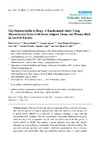Identificador persistente para citar o vincular este elemento:
https://accedacris.ulpgc.es/jspui/handle/10553/51242
| Campo DC | Valor | idioma |
|---|---|---|
| dc.contributor.author | Cuervo, Belen | en_US |
| dc.contributor.author | Rubio, Monica | en_US |
| dc.contributor.author | Sopena, Joaquin | en_US |
| dc.contributor.author | Dominguez, Juan Manuel | en_US |
| dc.contributor.author | Vilar Guereño, José Manuel | en_US |
| dc.contributor.author | Morales Doreste, Manuel Francisco | en_US |
| dc.contributor.author | Cugat, Ramón | en_US |
| dc.contributor.author | Carrillo, Jose Maria | en_US |
| dc.date.accessioned | 2018-11-24T22:46:46Z | - |
| dc.date.available | 2018-11-24T22:46:46Z | - |
| dc.date.issued | 2014 | en_US |
| dc.identifier.issn | 1661-6596 | en_US |
| dc.identifier.other | WoS | - |
| dc.identifier.uri | https://accedacris.ulpgc.es/handle/10553/51242 | - |
| dc.description.abstract | The aim of this study was to compare the efficacy and safety of a single intra-articular injection of adipose mesenchymal stem cells (aMSCs) versus plasma rich in growth factors (PRGF) as a treatment for reducing symptoms in dogs with hip osteoarthritis (OA). Methods: This was a randomized, multicenter, blinded, parallel group. Thirty-nine dogs with symptomatic hip OA were assigned to one of the two groups, to receive aMSCs or PRGF. The primary outcome measures were pain and function subscales, including radiologic assessment, functional limitation and joint mobility. The secondary outcome measures were owners' satisfaction questionnaire, rescue analgesic requirement and overall safety. Data was collected at baseline, then, 1, 3 and 6 months post-treatment. Results: OA degree did not vary within groups. Functional limitation, range of motion (ROM), owner's and veterinary investigator visual analogue scale (VAS), and patient's quality of life improved from the first month up to six months. The aMSCs group obtained better results at 6 months. There were no adverse effects during the study. Our findings show that aMSCs and PRGF are safe and effective in the functional analysis at 1, 3 and 6 months; provide a significant improvement, reducing dog's pain, and improving physical function. With respect to basal levels for every parameter in patients with hip OA, aMSCs showed better results at 6 months. | en_US |
| dc.language | eng | en_US |
| dc.relation.ispartof | International Journal of Molecular Sciences | en_US |
| dc.source | International Journal of Molecular Sciences [ISSN 1422-0067], v. 15 (8), p. 13437-13460, (Julio 2014) | en_US |
| dc.subject | 310907 Patología | en_US |
| dc.subject.other | Adipose Derived Mesenchymal Stem Cells | en_US |
| dc.subject.other | Plasma Rich In Growth Factors | en_US |
| dc.subject.other | Osteoarthritis | en_US |
| dc.subject.other | Dog | en_US |
| dc.subject.other | Hip | en_US |
| dc.title | Hip Osteoarthritis in Dogs: A Randomized Study Using Mesenchymal Stem Cells from Adipose Tissue and Plasma Rich in Growth Factors | en_US |
| dc.type | info:eu-repo/semantics/Article | en_US |
| dc.type | Article | en_US |
| dc.identifier.doi | 10.3390/ijms150813437 | en_US |
| dc.identifier.scopus | 84905661539 | - |
| dc.identifier.isi | 000341519600021 | - |
| dc.contributor.authorscopusid | 9532488300 | - |
| dc.contributor.authorscopusid | 9534772600 | - |
| dc.contributor.authorscopusid | 37071989800 | - |
| dc.contributor.authorscopusid | 21233262500 | - |
| dc.contributor.authorscopusid | 12770405100 | - |
| dc.contributor.authorscopusid | 7005533720 | - |
| dc.contributor.authorscopusid | 7202590467 | - |
| dc.contributor.authorscopusid | 57194687048 | - |
| dc.description.lastpage | 13460 | en_US |
| dc.identifier.issue | 8 | - |
| dc.description.firstpage | 13437 | en_US |
| dc.relation.volume | 15 | en_US |
| dc.investigacion | Ciencias de la Salud | en_US |
| dc.type2 | Artículo | en_US |
| dc.contributor.daisngid | 7071963 | - |
| dc.contributor.daisngid | 1882833 | - |
| dc.contributor.daisngid | 2284901 | - |
| dc.contributor.daisngid | 439294 | - |
| dc.contributor.daisngid | 913655 | - |
| dc.contributor.daisngid | 12043575 | - |
| dc.contributor.daisngid | 608093 | - |
| dc.contributor.daisngid | 30324417 | - |
| dc.description.notas | This article belongs to the Special Issue The Chondrocyte Phenotype in Cartilage Biology | en_US |
| dc.description.numberofpages | 24 | en_US |
| dc.utils.revision | Sí | en_US |
| dc.contributor.wosstandard | WOS:Cuervo, B | - |
| dc.contributor.wosstandard | WOS:Rubio, M | - |
| dc.contributor.wosstandard | WOS:Sopena, J | - |
| dc.contributor.wosstandard | WOS:Dominguez, JM | - |
| dc.contributor.wosstandard | WOS:Vilar, J | - |
| dc.contributor.wosstandard | WOS:Morales, M | - |
| dc.contributor.wosstandard | WOS:Cugat, R | - |
| dc.contributor.wosstandard | WOS:Carrillo, JM | - |
| dc.date.coverdate | Julio 2014 | en_US |
| dc.identifier.ulpgc | Sí | es |
| dc.description.sjr | 1,005 | |
| dc.description.jcr | 2,862 | |
| dc.description.sjrq | Q1 | |
| dc.description.jcrq | Q2 | |
| dc.description.scie | SCIE | |
| item.fulltext | Con texto completo | - |
| item.grantfulltext | open | - |
| crisitem.author.dept | GIR IUIBS: Medicina Veterinaria e Investigación Terapéutica | - |
| crisitem.author.dept | IU de Investigaciones Biomédicas y Sanitarias | - |
| crisitem.author.dept | Departamento de Patología Animal, Producción Animal, Bromatología y Tecnología de Los Alimentos | - |
| crisitem.author.dept | GIR Anatomía Aplicada y Herpetopatología | - |
| crisitem.author.dept | Departamento de Patología Animal, Producción Animal, Bromatología y Tecnología de Los Alimentos | - |
| crisitem.author.orcid | 0000-0002-2060-2274 | - |
| crisitem.author.orcid | 0000-0002-1436-8899 | - |
| crisitem.author.parentorg | IU de Investigaciones Biomédicas y Sanitarias | - |
| crisitem.author.parentorg | Departamento de Morfología | - |
| crisitem.author.fullName | Vilar Guereño, José Manuel | - |
| crisitem.author.fullName | Morales Doreste, Manuel Francisco | - |
| Colección: | Artículos | |
Los elementos en ULPGC accedaCRIS están protegidos por derechos de autor con todos los derechos reservados, a menos que se indique lo contrario.
